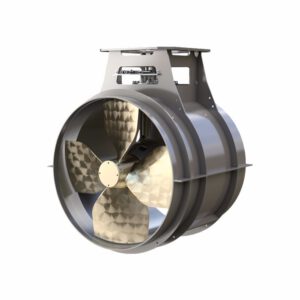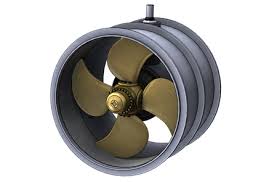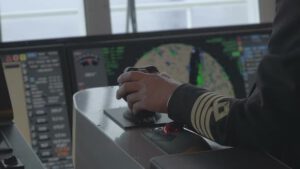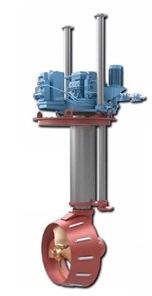AAM MARINE THRUSTERS
An azimuth thruster is a configuration of marine propellers placed in pods that can be rotated to any horizontal angle (azimuth), making a rudder unnecessary. These give ships better maneuverability than a fixed propeller and rudder system.
Types of azimuth thrusters
There are two major variants, based on the location of the motor:
1. Mechanical transmission, which connects a motor inside the ship to the outboard unit by gearing. The motor may be diesel or diesel-electric. Depending on the shaft arrangement, mechanical azimuth thrusters are divided into L-drive and Z-drive. An L-drive thruster has a vertical input shaft and a horizontal output shaft with one right-angle gear. A Z-drive thruster has a horizontal input shaft, a vertical shaft in the rotating column and a horizontal output shaft, with two right-angle gears.
2. Electrical transmission, more commonly called pods, where an electric motor is fitted in the pod itself, connected directly to the propeller without gears. The electricity is produced by an onboard engine, usually diesel or gas turbine.
DECK MOUNTED AZIMUTH THRUSTER

A Z-drive is a type of marine propulsion unit. Specifically, it is an azimuth thruster. The pod can rotate 360 degrees allowing for rapid changes in thrust direction and thus vessel direction. This eliminates the need for a conventional rudder. The Z-drive is so named because of the appearance (in cross section) of the mechanical driveshaft or transmission configuration used to connect the mechanically supplied driving energy to the Z-Drive azimuth thruster device.
This form of power transmission is called a Z-drive because the rotary motion has to make two right angle turns, thus resembling the letter “Z”. This name is used to differentiate the arrangement of drive to that of the L-drive. It does not refer to an electric motor in a rotating pod.
CONTRA ROTATING PROPELLER TUNNEL THRUSTER

Maneuvering thruster (bow thruster or stern thruster) is a transversal propulsion device built into, or mounted to, either the bow or stern, of a ship or boat to make it more manoeuvrable. Bow thrusters make docking easier, since they allow the captain to turn the vessel to port or starboard side, without using the main propulsion mechanism which requires some forward motion for turning; The effectiveness of a thruster is curtailed by any forward motion due to the Coandă effect.
A stern thruster is of the same principle, fitted at the stern. Large ships might have multiple bow thrusters and stern thrusters.
Large vessels usually have one or more tunnel thrusters built into the bow, below the waterline. An impeller in the tunnel can create thrust in either direction that makes the ship turn. Most tunnel thrusters are driven by electric motors, but some are hydraulically powered. These bow thrusters, also known as tunnel thrusters, may allow the ship to dock without the assistance of tugboats, saving the costs of such service.
Ships equipped with tunnel thrusters typically have a sign marked above the waterline over each thruster on both sides, as a big cross in a red circle: (x). Tunnel thrusters increase the vessel’s resistance to forward motion through the water, but this can be mitigated through proper fairing aft of the tunnel aperture. Ship operators should take care to prevent fouling of the tunnel and impeller, either through use of a protective grate or by cleaning. During vessel design, it is important to determine whether tunnel emergence above the water surface is commonplace in heavy seas.
CONTROLLABLE PITCH PROPELELR TUNNEL THRUSTER

Mechanical azimuth thrusters can be fixed installed, retractable or underwater-mountable. They may have fixed pitch propellers or controllable pitch propellers. Fixed installed thrusters are used for tugboats, ferries and supply-boats. Retractable thrusters are used as auxiliary propulsion for dynamically positioned vessels and take-home propulsion for military vessels. Underwater-mountable thrusters are used as dynamic positioning propulsion for very large vessels such as semi-submersible drilling rigs and drillships.
FIXED PITCH PROPELELR TUNNEL THRUSTER

Mechanical azimuth thrusters can be fixed installed, retractable or underwater-mountable. They may have fixed pitch propellers or controllable pitch propellers. Fixed installed thrusters are used for tugboats, ferries and supply-boats. Retractable thrusters are used as auxiliary propulsion for dynamically positioned vessels and take-home propulsion for military vessels. Underwater-mountable thrusters are used as dynamic positioning propulsion for very large vessels such as semi-submersible drilling rigs and drillships.
CONTROLS

DECK MOUNTED AZIMUTH THRUSTER:
– Bridge Control Panel
– Central Control Box
– Local Control Panel
– Local Control Box
– Proportional Valves for Steering, Lifting and Tilting
Hydraulic Unit (CPP Tunnel Thruster) includes: Oil Tank, Hydraulic Pump and Valves
Remote Control System Including motor starter, E-Motor, Control Panel, Central Control Box



